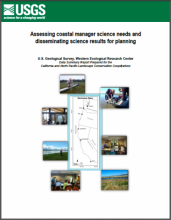Assessing coastal manager science needs and disseminating science results for planning

Coastal land managers are faced with many challenges and uncertainties in planning adaptive strategies for conserving coastal ecosystems under future climate change scenarios. As transitional ecotones between the marine and terrestrial environment, nearshore habitats are particularly sensitive to climate change. Projected climate change effects on coastal environments include sea-level rise, changing storm magnitude and frequency, salt water intrusion, accelerated erosion, shifting mudflat profiles, and increased water temperature and acidity (Huppert et al. 2009). Sea-level rise ranging from 0.43 m to 1.66 m by 2100 (NRC 2012) could potentially inundate thousands of acres of coastal habitats if accretion processes are not able to keep pace. Climate effects will vary both temporally and spatially; therefore, planning, coordination, and data collection is best performed at local sites that can be compared across a wide range of Pacific coast sites.
The USGS Coastal Ecosystems Response to Climate Change (CERCC) program (http://www.werc.usgs.gov/cercc) uses a bottom-up local approach to assess the vulnerability of tidal wetland habitats from climate change. Our goal is to use detailed site data and analyses of elevation, inundation, tidal range, accretion, and plant communities to examine effects of climate change on these habitats. By collecting extensive field data, monitoring site conditions, and developing site-specific sea-level rise response models, our approach informs management decisions at a local level, but is applicable at a regional level.
To facilitate communication and outreach of sea-level tidal marsh modeling results, we convened managers, biologists, Tribes, and other important decision makers and partners and hosted in-person workshops with stakeholders in six Pacific coast estuaries. Our objectives were: (1) disseminate site-specific baseline data and modeling results, reveal coast-wide trends, and identify data gaps; (2) identify how local climate science results may be incorporated into habitat conservation, planning, and adaptation strategies; and (3) develop an understanding of coastal climate change science needs to inform the California and North Pacific Landscape Conservation Cooperatives (LCC).
Thorne, K.M., Powelson, K.W., Bui T.D., Freeman, J.Y. Takekawa, C.M., Janousek, C.N., Buffington, K.J., and D.L. Elliott-Fisk 2016. Assessing coastal manager science needs and disseminating science results for planning. Data Summary Report Prepared for the
California and North Pacific Landscape Conservation Cooperatives. USGS Western Ecological Research Center, Vallejo, CA. 110 pp.
